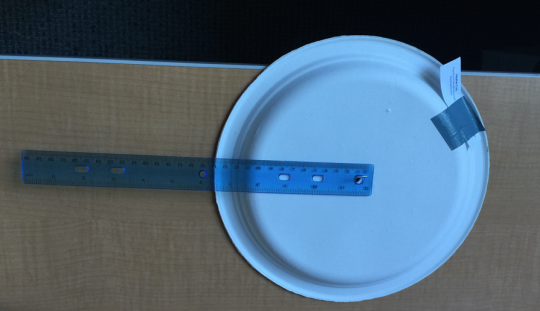Lesson 1: Make a Trundle Wheel
In the warm-up, students brainstorm methods to measure walking distances in order to design a course for a 5K race on their school grounds. In the main challenge, groups of 3 students make surveyor wheels.
Activities:
Setup
Pick an appropriate path that students can measure. It has to be long enough so that it cannot be measured with a measuring tape. It should be at least 50 yards/meters. If the weather is likely to be bad, an indoor hallway or the gym works just fine.
Narrative
Students brainstorm ideas about how to measure long distances, possibly over uneven terrain. In groups, try out different methods and compare their methods. This warm-up could take place in a prior class and additional time would allow for students to share more methods and to test how accurate different methods are.
Launch
Form teams of 3 (which will stay together throughout cycle). Provide teams access to common measurement tools.
- Explain that they are asked to design a 5K course on the school grounds. Ask: “Has anybody participated in a run or walkathon before? How did this work?”
- Ask them to brainstorm what is involved in planning the course (3-5 minutes).
- Invite students to share some ideas. Direct the discussion towards where and how long the course will be. If students don’t generate this idea, include it “I wonder how we will know how long the course will be.”
- Ask students to come up with method to measure the course, including any tools they would need.
Task Statement
The school is considering holding a 5K fundraising walk on the school grounds. We are supposed to design the course for the walk.
- How can we measure the course? Come up with a method that we could use.
- Discuss in your group: What worked well? What made your method hard to use?
Orchestrating & Monitoring
- As students brainstorm, listen in on their conversations and make note of groups that mention the path of the course, where it will go and how long it will be.
- As students are planning their measuring methods, provide tools (if available) or tell them that they need to modify their method because the tool they want is not available.
- How can we measure the course? Come up with a method that we could use.
- Let’s see how close your different methods are to each other. Use your method to measure the distance across the school yard.

Discussion
Invite students to share their solutions. In the discussion, compare how close their answers are. Compute the approximate relative error (difference/total length), discuss the advantages and disadvantages of their methods and sources of discrepancies in their measurements.
Consider asking the following questions:
- “We all measured the same distance, how close are the answers that you got?”
- “Why are the answers so different?”
- “What worked well and what didn’t work well with your measuring method?”
Anticipated Solutions
- We need to find a course, measure it and then figure out how often you have to go around it to complete 5 km.
- Solutions vary. Here are two:
- Use a measuring tape over and over again.
- Measure your stride length and then count the number of strides.
- Answers vary
- Answer vary. For the two methods given:
- Advantages: Can be very accurate as long as you are careful. Disadvantage: It takes two people and is quite cumbersome. If you are not careful, each time you move the tape you introduce an error. So this is not very practical for long distances and if there are a lot of corners to go around.
- Advantages: Very easy to do and very quick. Disadvantage: Not all strides are equal. The longer the distance, the more chances for errors are there.

Narrative
Students read a brief paragraph describing a trundle wheel, and see a picture of a surveyor using one. They draw a rough sketch and discuss (1) how they could construct such a device and (2) how to use it. Students then make a usable surveyor wheel using different size paper plates and yard sticks. (other materials are possible to use.)
Launch
Students work in same 3-person groups.
Orchestrating & Monitoring
A tool that surveyors use to measure distances is a surveyor wheel or sometimes called a trundle wheel. Here is the description of a trundle wheel:
“The trundle wheel is a measuring device, a simplified form of a surveyor's wheel. It is commonly used by people who need an easy way to find the rough distance from one place to another. The trundle wheel is composed of a wheel, a handle which is attached to the axle allowing the trundle wheel to be held easily, and a clicking device which is triggered once per rotation of the wheel.” (Source: https://en.wikipedia.org/wiki/Trundle_wheel) https://upload.wikimedia.org/wikipedia/commons/7/75/NRCSUT97016_-_Utah_(6507)(NRCS_Photo_Gallery).jpg
- How could we construct a simple trundle wheel? Draw a rough sketch.
- How exactly would we use the trundle wheel?
- Construct a trundle wheel using the supplies I brought for us today.
Discussion
Groups come together with their wheels and explain their designs. They demonstrate that their wheel works by walking across the classroom and counting “clicks” that correspond to rotation.
Anticipated Solutions
There are many different solutions. A simple, yet serviceable trundle wheel is shown in the photo.
Materials for this Lesson:
Check previous page for materials.
Timeline:
- Activity 1 - Warmup: 20 minutes
- Activity 2 - Planning a 5k course: 30 minutes
- Lesson Wrapup: 5 minutes

